20 Historical Events That Would Make Great Movies
History, a subject that either galvanizes people or bores them to tears. Despite your views on history there is no denying that writers and filmmakers have looked to historical events for interpretation, from Spartacus' rebellion, to the Scottish War for Independence to
Abraham Lincoln's efforts to pass the 13th Amendment. A film about the evacuation of Dunkirk was a passion project for Christopher Nolan and the critical reception suggests that it's an Oscar contender.
Yet there are many historical events and figures that have not received a cinematic adaptation and could be become great films, from action/war films, to dramas, to comedies.
There is admittedly a bias towards English and British history and the events here are listed in chronological order.
Peloponnesian War
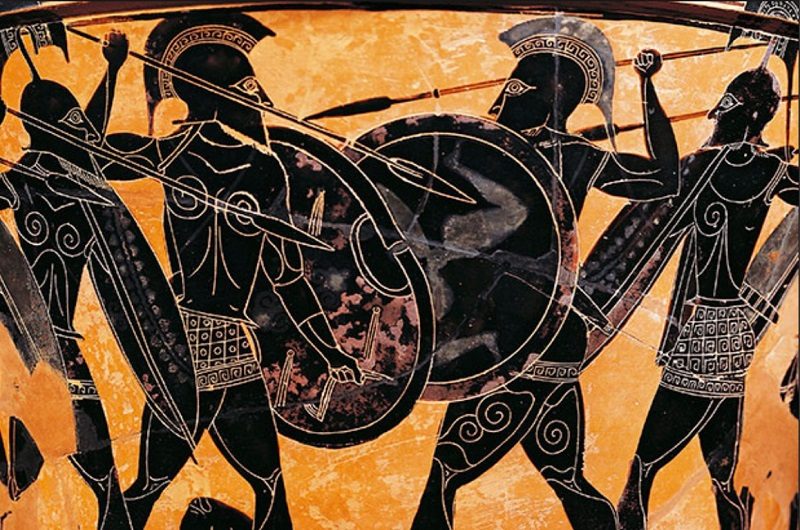
The Peloponnesian War was a conflict between the Delian League led by Athens and Peloponnesian League that was lead by Sparta and supported by Persia (certainly puts
300 in a different light). It was a war that fought across Greece, Asia Minor and Sicily. The aftermath saw Greece fall to Spartan hegemony and ended Athenian democracy with the city being ruled by the Thirty Tyrants.
The Peloponnesian Wars saw a change in Greek warfare, turning from battles between heavily armored men in tight formations to bloodier affairs, where atrocities became more common and taboos were broken, like destroying religious sites.
Near the end of the war the famous philosopher Socrates was executed for his stance against democracy and his student Plato wrote
The Republic. The Peloponnesian War has been seen as a failure for the Athenian model of Democracy and the trial of Socrates could be made as a condemnation of power the of the mob.
This was also the period the Athenian general and politician Pericles was alive and made his famous funeral oration which is one of the defenses of democracy.
The Life and Career of Hannibal Barca
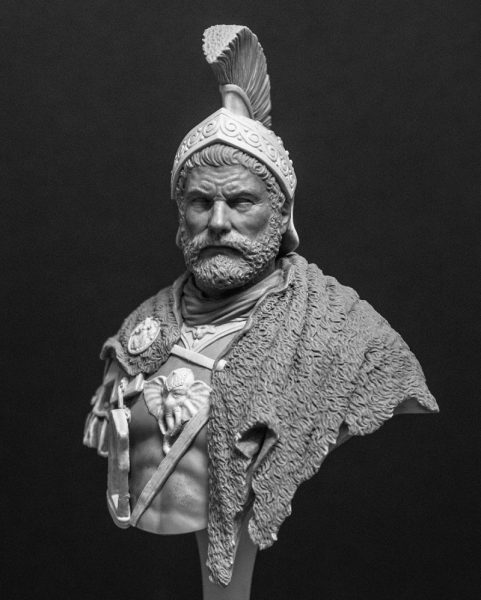
Hannibal is known as for being one of the best generals ever to have lived, the scourge of the Roman Empire and so influential that military academy still teaches his greatest successes. Hannibal fought for Carthage, an empire based in the Mediterranean that stretched across North Africa, Spain and islands like Corsica, Sardinia and Sicily and he was the great rival of Rome.
Hannibal started his military career in Spain and fought during the Second Punic War that lasted 17 years. Some of his greatest actions included crossing The Alps, a high-risk strategy - one-third of his forces died during the crossing but was able to bypass the Roman navy and surprised the Roman Republic by attacking their heartland. In Italy, Hannibal won three major battles, Trebia River, Lake Trasimene and Cannae. Canne was a complete humiliation for the Romans but as Hannibal's cavalry commander, Maharbal, said: "Hannibal knew indeed how to gain victories, but not how to use them." The Republic never surrendered and Hannibal never charged on Rome which would have forced their hand.
The Second Punic Wars also saw the rise of Scipio Africanus, an expert politician and military commander. He fought in Spain and was so popular with his troops that they wanted to crown him king, but Scipio refused. Scipio was able to force the Senate to allow him to invade Carthage and defeated Hannibal at the Battle of Zama.
All this material about Hannibal and the Second Punic War might be better served in a big budget mini-series, having production values like
Rome or
Game of Thrones. A film could still work, either as a three hour long epic or focus on a specific event like Hannibal's invasion of Italy, showing how the Roman Republic was brought to its knees.
The Battle of the Teutoburg Forest
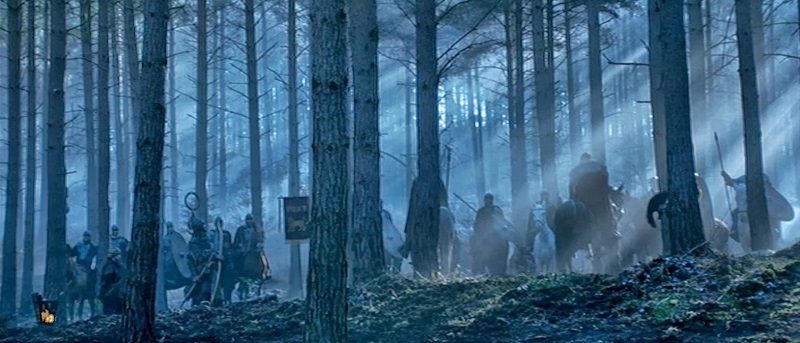
In the year 9 AD the Roman Empire was at the height of its power, a dominant superpower under the rule of its first Emperor Augustus. One of the Empire's greatest defeats was losing against the Germanic Tribes in the forests of the North Rhine-Westphalia region of Germany and being forced to withdraw from Magna Germania.
At the time the Roman Empire was trying to expand beyond the Rhine and tame the Germanic tribes. Publius Quinctilius Varus, a general and politician with a reputation for being harsh, was sent the govern the province. However, Varus was tricked by Arminius, a Germanic prince who was raised as a Roman. Varus sent three legions to crush a potential uprising, leading him into the Teutoburg Forest but Arminius forced the Romans down narrow forest paths and used hit and run tactics to deplete the Roman forces, demoralizing the legions leading to a complete defeat. It was estimated that the Romans lost between 15,000-20,000 Legionaries and was forced to temporarily withdrawal from Magna Germania.
During the battle Varus and many other officers took their own lives. The Roman historian Suetonius reported that the Emperor was in a traumatized state, repeatedly shouting "Quintillius Varus, give me back my legions!" Arminius was considered to be a power-hungry politician, learning the Romans and planned to be the ruler of the Germanic Tribes - he was assassinated 10 years later by rival Germanic chiefs.
Boudica's Uprising
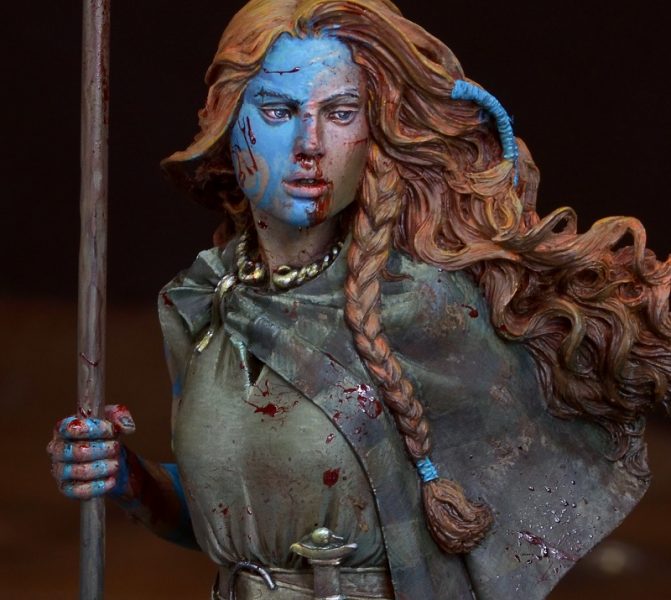
Boudica is a legendary figure in the United Kingdom, especially in England, the woman who defied an Empire and nearly forced the Romans out of Britain during her rebellion in of 60-61AD. The story of Boudica has already been explored by Entertainment Fuse,
we suggested 10 actresses who play the famous red-head. Boudica's Rebellion has the perfect story template for a historical epic, similar to
Spartacus,
Gladiator and
Braveheart. It would be brutal and bloody and could give the genre a feminist twist.
Boudica was married to Prasutagus, king of the Iceni tribe in modern-day Norfolk, England and an ally to the Roman Empire. When he died he left half his kingdom to the Roman Emperor and the other half to his daughters. However, the Romans refused to enact the deal, called in their loans and the kingdom was pillaged. Boudica was publicly flogged and her daughters were raped, an action that angered the Britons; they united behind Boudica. Boudica led the Britons to sack the Roman towns of Camulodunum, Londinium and Verulamium, burning them to the ground before being defeated at the Battle of Watling Street and taking her own life afterward.
Filmmakers wouldn't need to change the basic details to tell a good story and they will have some artistic license regarding Boudica's character because the only sources about her are Roman. There would have a ready-made villain in the form of Gaius Suetonius Paulinus, the Governor of Britain and was so brutal that the notorious Nero called him back to Rome after the campaign. Filmmakers could emphasis on themes of suppression and colonization, fighting off a foreign force, or look at the psychological impacted of the attack on Boudica, being a woman driven by a bloodthirsty vengeance.
Siege of Masada
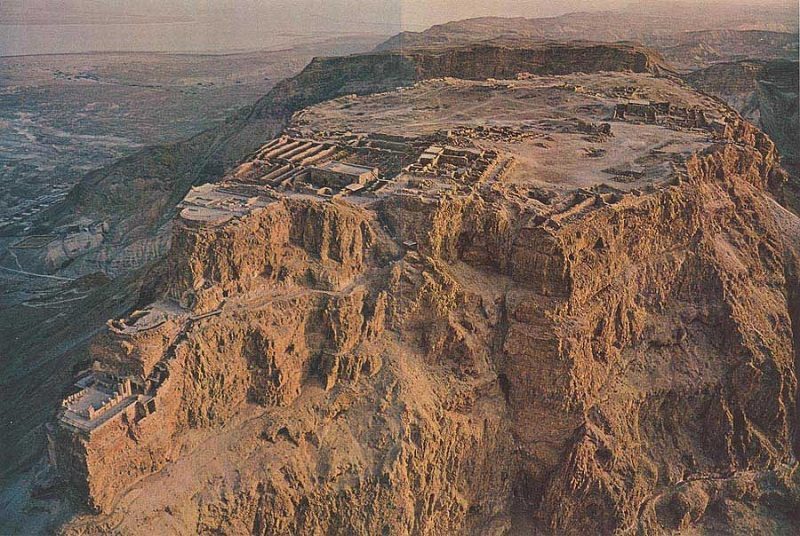
The First Jewish-Roman War, also known as the Great Revolt, took place from 66 to 73AD in Judaea, modern day Israel and Palestine. One of the most famous events of this war came at the end of the conflict when the Romans laid siege of the Masada fort that was held by 960 Sicarii rebels, a group of zealots. Instead of surrendering the rebels committed mass suicide where only two women and five children survived.
This is a controversial event in Jewish and Israeli history and opinion is divided on how to treat the Sicarii rebels. Some argue that they were martyrs who fought bravely against the Romans and their deaths helped forge Israeli national identity. The other opinion is the Sicariis were just religious extremists who defied Jewish doctrine and serves as an example against people who twist religion for their own ends.
A film about Masada would certainly be interesting because it could explore what made the Sicarii tick and be a film about a cult in a historical setting. The desert setting and blood-letting could lead to a lot of Old Testament style imagery.
Battle of Tours
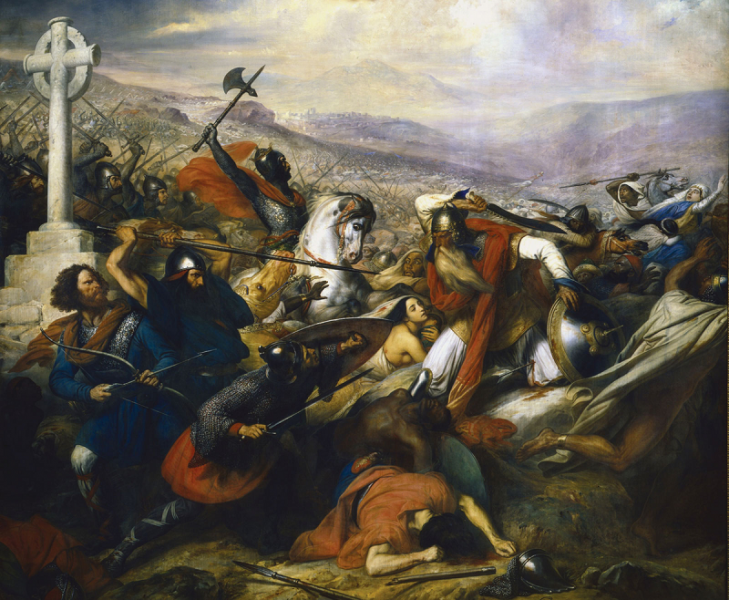
The Battle of Tours took place in 732 AD and it has been as a defining moment in European and Christian history because it prevented the Moors from advancing into Europe. The Moors were Arabs who conquered the most of the Iberian Peninsula (modern day Spain and Portugal) and attempted to invade the territory that would become France and the Moorish invaders marched to the rich city of Tours. However, the invasion led to warring kings and noblemen to unite to fight the foreign invaders, led by Charles Martel, Charles the Hammer. Despite being outnumbered and the Moors using cavalry the Christian forces were able to stand their ground and repel the invaders and even killed the Moors' commander, Abdul Rahman Al Ghafiqi.
There is a risk that a film about Battle of Tours could be hijacked by racists and Islamophobes, celebrating it as a story of Christianity's 'superiority' over Islam. To avoid this the film should either focus on the battle itself, show that 8th century was a brutal and unpleasant time regardless of ethnicity or religion or focus on Charles Martel who forms alliances and uses the victory to ignite his own ambitions for power (his grandson was Charlemagne).
The Gunpowder Plot
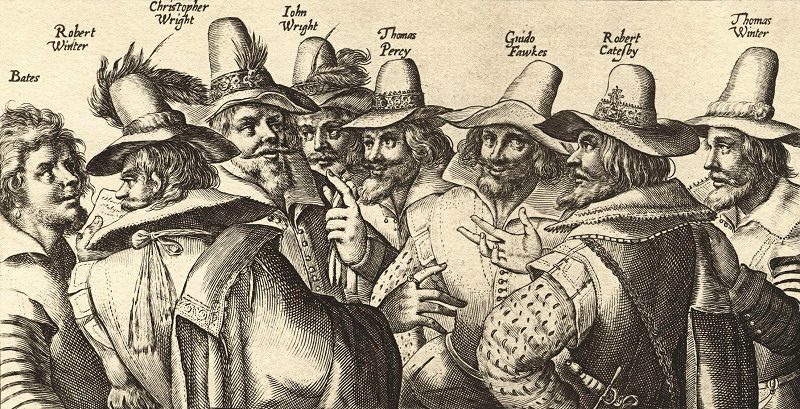
"Remember, remember the fifth of November, Gunpowder treason and plot. We see no reason why gunpowder treason should ever be forgot!" The Gunpowder Plot that is taught to schoolchildren across England and commemorated with fireworks, bonfires, effigies and the annual searching the Palace of Westminster's cellars. However, most people outside the UK will properly know the event more because of
V for Vendetta. Despite The Gunpowder Plot's cultural importance, there has never been a film about the Gunpowder Plot although there have been two miniseries.
The Gunpowder Plot took place within two years of the reign of James I (also James VI of Scotland), the Protestant king of Scotland who became the ruler of a religious divided England and was considered to be more tolerant of the Catholic faith than Elizabeth I. The conspirators, led by Robert Catesby planned to blow up the opening of Parliament, killing the king, his heir and many important MP and Lords and kidnap Princess Elizabeth so they could take over the regency.
A film about the Gunpowder Plot has a ready-made three act structure: James I becomes the king of England promising more religious tolerance but fails to enact on his promise, the conspirators plan to blow up Parliament and when they are found out they are tortured, tried and publicly executed in a brutal manner and the government unleashes a brutal backlash against Catholics in England.
There are two ways to make a film about The Gunpowder Plot: the first is it being a condemnation of an extremist group whose selfish actions made the conditions for Catholics in England even worse, ignoring Papal orders against rebellion. Many historians believe that even if the Plot was successful the results for Catholics would have been the same. The other way to go is to portray the conspirators as people forced to undertake this extreme action and martyr themselves for a greater cause. If filmmakers use the second option, they could easily use a lot of Catholic imagery and metaphor and the execution of Fr. Henry Garnet, the Jesuit Superior in England and loosely connected to the conspirator could have a certain level of martyrdom. During his execution the crowd pulled on his legs to kill him more quickly, sharing him the torture being quartered. When Garnet was beheaded there was no applause.
A more controversial story idea would be to look at the conspiracy theory that the Gunpowder Plot was an inside job lead by the Earl of Salisbury, framing Catholics so he could launch a new wave of terror.
The Careers of Edmund Burke and Thomas Paine
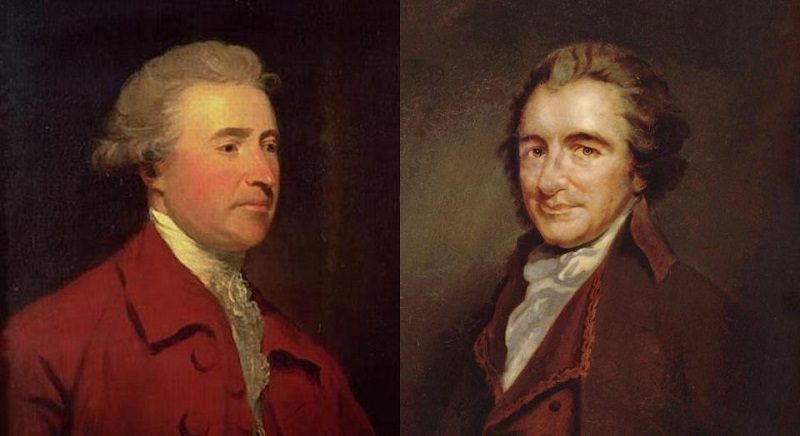
Edmund Burke and Thomas Paine were two different yet equally important political figures from in the late 18th Century whose ideas impacted the modern world. Edmund Burke was the MP for Bristol, part of the Whig Party in the House of Commons and considered the father of modern conservatism. Thomas Paine was a political radical and became an important figure in the American and French Revolutions.
During the American Revolution Burke and Paine were unlikely allies: both supported the American Revolution, although for different reasons. Burke saw fighting the American Revolutionaries as pointless because the British and Americans had the same political and ideological grounding and that the American Revolutionary was an evolution of the British system. Paine wrote the pamphlet "Common Sense" in 1776 and it was seen as one of the first text arguments for armed resistance. Written in deliberately easy to read style it sold 100,000 copies at time and it was considered one of the most important pamphlets during the revolution.
It was during the French Revolution where the two men were opposed to each other. Paine when to France to support the revolution while Burke wrote his influential text "Reflections on the Revolution in France", the book that was the bedrock for conservative ideology in 1790 as well as an attack on actions of the French Revolution because he thought political change would eventually happen.
Paine's response was publishing his most famous pamphlet "Rights of Man", arguing that the revolution was justified because the people were overthrowing a tyrant abusing his position.
A rivalry flared up in 1792 when Paine attacked Burke and led to his trial and conviction for seditious libel, done in absentia. Paine was also elected to the French National Convention but was arrested and imprisoned in December 1793, luckily escaping with his life.
Despite the men possibly never meeting, a film or miniseries about both men who would be an interesting exploration of two men who were ideologically opposed at a time of political upheaval and examination of what makes them tick. There is a risk that a production about political philosophy would be a turn off for audiences, but films like
Lincoln and TV shows like
House of Cards have proven that people will watch media about politics.
Battle of Trafalgar
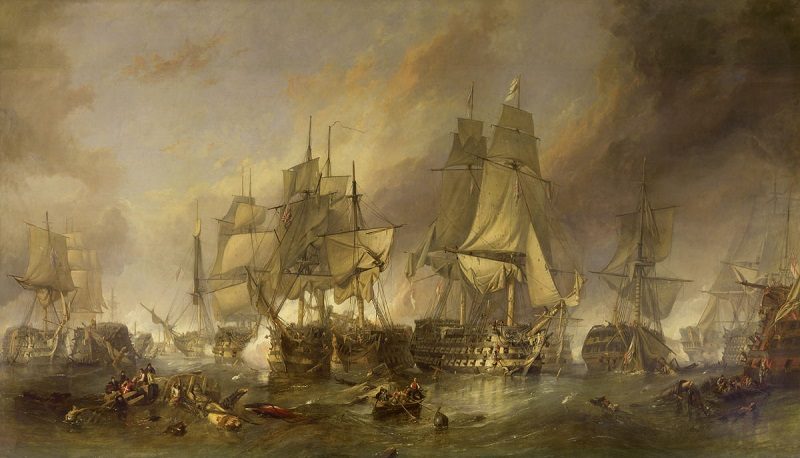
The Battle of Trafalgar is a battle that stands alongside Agincourt and Waterloo that fill Englishmen with patriotic pride and for a nation known for its naval tradition Trafalgar is considered one of its most important victories. Before the battle war between Britain and France flared up and Napoleon wanted to invade Britain. But for any nation to invade Britain they need control of the seas. Just off the coast of Cape Trafalgar in the South-west of Spain Admiral Horatio Nelson launched an attack against a joint French-Spanish fleet and despite being outnumbered the British did not lose a single ship while the French and Spanish lost 21 ships. The battle tactics were revolutionary and Trafalgar is still studied by aspiring naval officers. However, despite it being Nelson's greatest triumph he died during the battle.
Films about naval warfare are expensive because of the sets required and shooting on water being incredibly difficult but a film about the Battle of Trafalgar is still perfectly possible. 2003's
Master and Commander: The Far Side of the World was set in the same period was a critical hit and nominated for 10 Oscars, it just had the misfortune of competing against
Lord of the Rings: Return of the King and its award winning clean sweep. 2003 also saw the release of
Pirates of the Caribbean: Curse of the Black Pearl which was a huge hit and started a popular series. The
Pirates of the Caribbean could serve as an example of how a film about the Battle of Trafalgar could face the technical challenge and be the basis for how to shoot action scenes and art direction. A Battle of Trafalgar could be a great film to show the hardship of naval life at the time and be violent because of cannonballs shaming into ships and men having to fight hand-to-hand battles.
The other way to go would be to make a biopic about Nelson, a man from a modest background who rose up the ranks and was popular with the people but hated by the Admiralty. He led the Royal Navy to victories in Egypt and Denmark, but was seen as a maverick and attracted scandal when he had an affair with Emma Hamilton. When he died Nelson had a state funeral which 32 admirals and over hundred captains attended and an escort of 10,000 soldiers but his wife and daughter were not allowed to attend.
The Presidency of Andrew Jackson
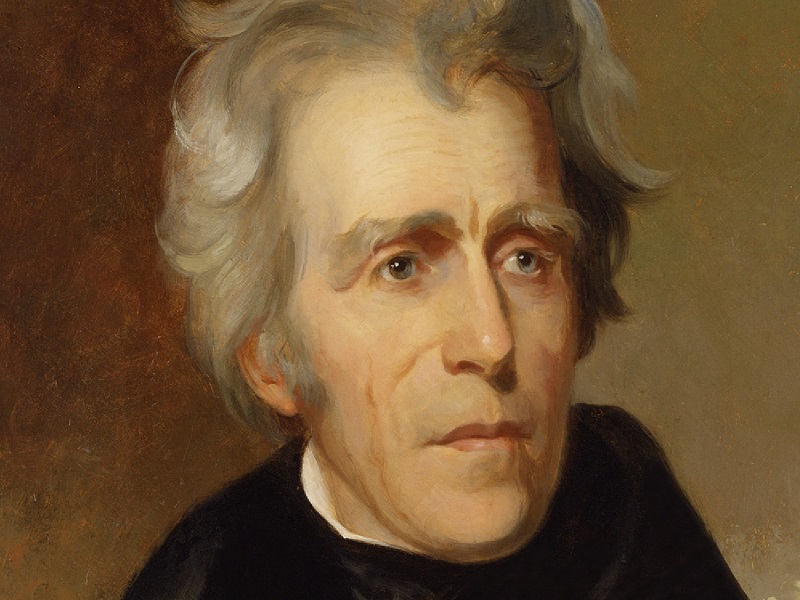
Andrew Jackson is often considered to be the insane man to hold the office of President of the United States and the current occupant of the White House has been compared to the man on the 20 dollar bill - so it would be timely for a film about Jackson's time in office to be made. Before running for office Andrew Jackson was a general before becoming President, commanding the US Army during the Battle of New Orleans and was the military commander in Florida, fighting against Native American tribes without the authorization of the Federal Government. Jackson was also known for having a violent temper and fondness for dueling
Jackson ran on a populist platform and during the 1828 Presidential Election he campaigned using his military experience and criticized his opponent John Quincy Adams for his intellect. During Jackson's inauguration he hosted a drunken party at the White House and was the first sitting president to survive an assassination attempt and when the would-be assassin's pistols failed to fire Jackson beat him with his cane.
Jackson was also known for expanding Presidential power. During his time in office he ran afoul with South Carolina during the Nullification Crisis which nearly led to the army and navy to the collect taxes and forced to renew the Second Bank of the United States which led to the Panic of 1837. He also used the Presidential veto as a political weapon and notorious for cronyism. His most notorious act was supporting the Indian Removal Act which led to the Native Americans being forced from the lands in the South and moved Westwards. The Native Americans' even successfully sued the government and Jackson supposed reaction was 'let's see how the court would enforce it'.
A biopic about Jackson's political life could happen in two ways: the first could be a serious political drama where a powerhungry mad man was able to appeal to the masses and attempts to fight against the system of checks-and-balance. The other way would be a dark comedy about a clearly insane man holding the highest office in the land. Either way the film could act as a critique of Donald Trump.
The Founding of HMP Pentonville
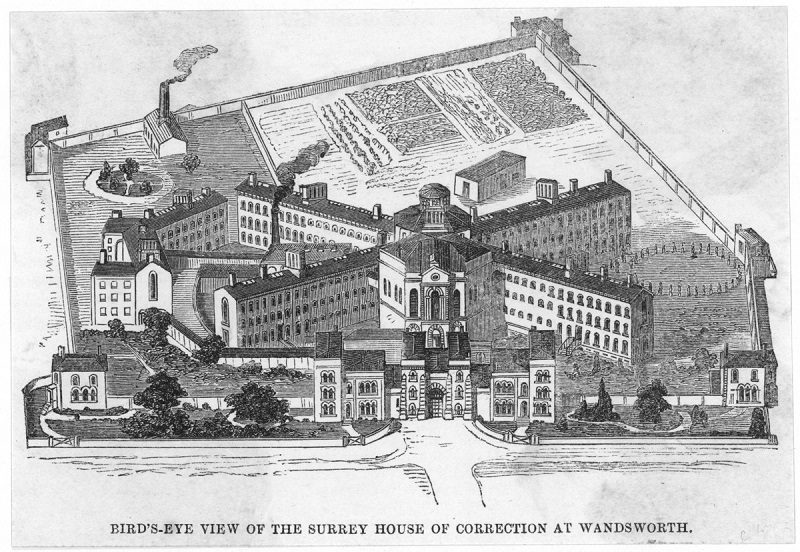
HMP Pentonville was a Victorian prison that opened in 1842 and was seen as a response to the criminal justice system known as 'The Bloody Code' by its critics. It was during this period that saw a change in how crimes were punished in the UK, moving away from physical punishment to punishing the mind and within the walls of Pentonville extreme measures were taken. Prisoners were forced to wear masks and were not permitted to speak to each other. At night prisoners screamed in pain because of the psychological torment and within Pentonville there were 220 cases of insanity, 210 cases of delusion and 40 suicides. This experiment in criminal justice would be a perfect setting for a historical horror film where prisoners undergo this cruel and unusual punishment, an eerie setting of faceless people and silence and prisoners' sanity pushed to the brink.
Mary Seacole
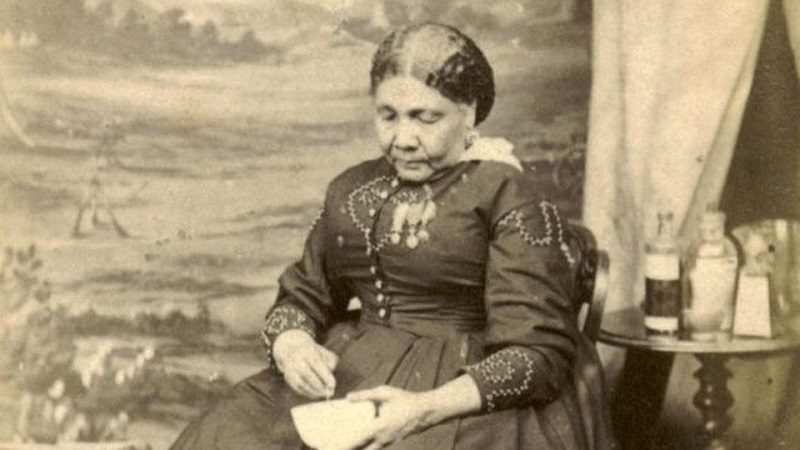
When people think of pioneer of modern nursing Florence Nightingale is the face of it and made a hero of the Crimean War. However, a contemporary that was just as important and but largely forgotten was Mary Seacole.
Mary Seacole was mixed-race Jamaican woman who trained as a nurse who treated gold prosperities who was traveling through Panama before moving to London to volunteer to serve in the war effort but was rejected by the Ministry of War. Despite this Seacole went to the Crimea to treat British troops privately in the British Hotel near Balaclava and became popular with the troops.
Seacole was a well-known figure in the Victorian England, she was one of the first mixed-race women to write an autobiography and because of her charitable work her financial situation fluctuated, yet her legacy was forgotten until recently. I only found out about her when studying A-Level Sociology and she was used as an example about how the achievements of people from ethnic minorities are marginalized. She was posthumously awarded the Jamaican Order of Merit in 1991 and was voted the greatest black Briton.
A film about Seacole would focus on her time in the Crimea, how she had used all her money and be extremely resourceful to set up the British Hotel and show a woman with huge passion and compassion in an era where she would have suffered incredible prejudice.
The Battle of Verdun
[caption id="attachment_99826" align="aligncenter" width="627"]
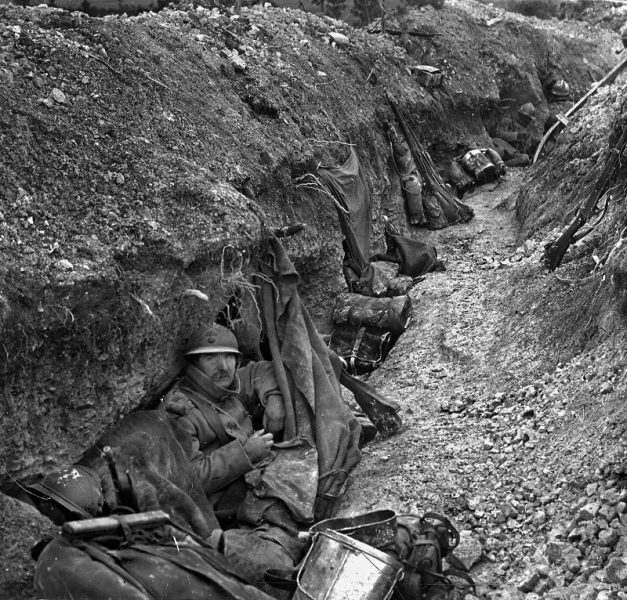
World War One, Battle of Verdun. French trench on the front lines, 1916. (Photo by Roger Viollet/Getty Images)[/caption]
The Battle of Verdun one of the most costly battles in human history, let alone in World War One. Commencing from 21 February 1916 to 18 December 1916 the battle was fought between the French and the German armies. The battle tactics were a cynical disregard for human life and a symbol of the worst stereotypes of military tactics during the First World War. The aim of the battle from the German point-of-view was to make the battle so bloody that it would force the Allies, particularly the French to sue for peace because of the huge loss of life. The aim of the Germans was to attack Verdun and the action would force the French reserves into the battle.
The battle was the brainchild of Erich von Falkenhayn, the Chief of the German Staff, and can easily be the villain of the piece because his aim was simply to cause as much death as possible. A film about the Battle of Verdun could follow in the tradition of
All Quiet on the Western Front and
Paths of Glory, showing brave men, fighting in horrific conditions, but were nothing more than pawns of the higher ups who live in luxury.
The Great Emu War
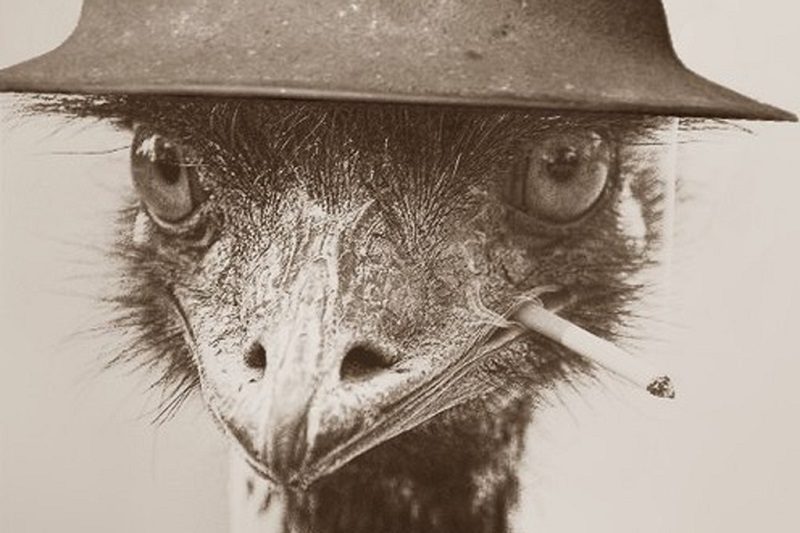
Pretty much all these entries on this list are major events and most would be serious dramas or war films, so let's look at an event that would be turned into an outright comedy: The Great Emu War of 1932.
After the First World War a large number of Australian and British veterans moved to Western Australia to become farmers. However, the new farm land was directly in the path of Emu migration routes and the new farmers lobbied the Australian government to help them cull the animals. The Australian government sent one officer and two soldiers with a machine - the government reasoning being the Emus would be good target practice. What happened was the birds outsmarted the military: the first attempt to shoot the Emus resulted in failure when the gun jammed and the birds ran off and scattered. The officer in command then decided to put the machine gun on the back of a truck but when it came to be used the soldier was unable to use it because he had to hang on for dear life. In the end, 986 emus were killed at a ratio of 10 bullets used to kill one bird and the Australian army withdrew in humiliation.
Group Captain Douglas Bader
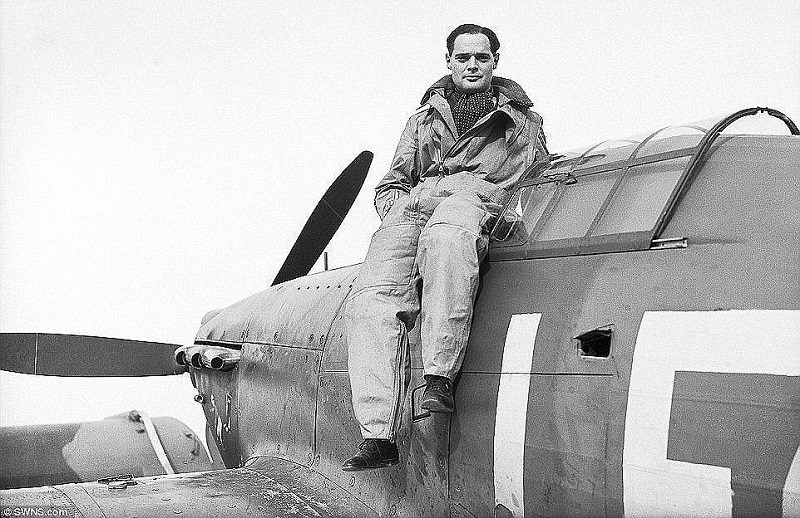
Douglas Bader was a Royal Air Force pilot who served during the Battle of France and Battle of Britain. What makes his story even more remarkable was he lost both his legs in an accident in 1931 and was forced to retire from the military and only allowed back into the RAF as a pilot because of the outbreak of war.
Bader was recorded having 22 aerial victories, for shared victories, six probable victories, one probable shared victory and damaging 11 enemy aircraft. An impressive record for any pilot. Bader was also not afraid to ruffle feathers with the RAF, supporting the Big Wing theory which was a huge debate at the time.
Bader was captured by the Germans after being shot down over France and despite his disability attempted to escape, leading him to be transferred to 'escape-proof' Colditz Castle.
After the war Bader became a campaigner for disabled rights and earned himself a knighthood in 1976 because of his work.
The Battle of El-Alamein
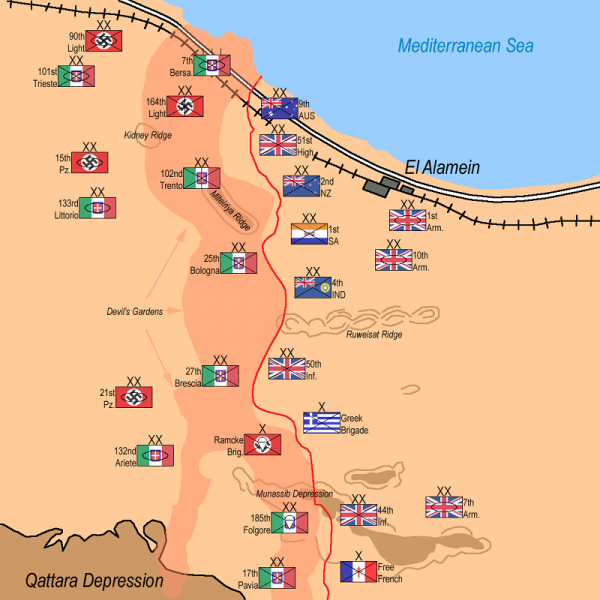
The Battle of El-Alamein is an important turning point in the North Africa Campaign where the Nazi advance was halted and pushed back once and for all, giving the Allies a morale boosting victory. A film about El-Alamein could see a return of films about major battles, like
The Longest Day, Tora Tora Tora and
A Bridge Too Far, looking at the commanders and men on the ground.
The Battle of El-Alamein was really two battles. The first was a defensive battle designed to stop the Germans and took place from 1 July to 27 July 1942. The second battle took place three months later and saw the Allies advance against the Germans, coinciding with Operation Torch, the Allied invasion of French North Africa.
The most obvious way to make a film about El-Alamein would be to focus on the two commanders, Field Marshall Erwin Rommel of the Panzerarmee Afrika, nicknamed the Desert Fox and Lieutenant-General Bernard "Monty" Montgomery, taking over command of the Allied Army for the Second Battle. A film would focus on the commanders' preparation for the battle and the tactical battle of wits between two of greatest commanders during the war while also facing pressure from their political superiors. Montgomery was tasked to lead an offensive battle because the Soviets demanded an attack to alleviate pressure on the Eastern Front.
The Arctic Convoys
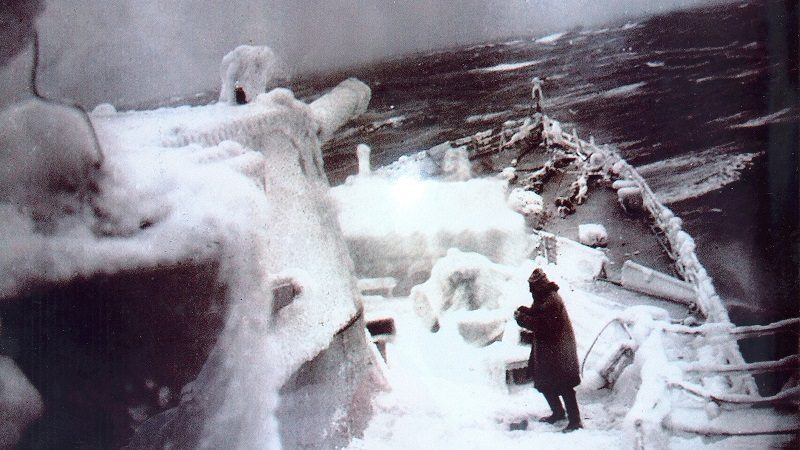
Winston Churchill called the Arctic Convoys 'the worst journey in the world', a hard arena of war where the Allies sent materials and aid to support the Soviet War Effort. After the Nazis invaded the Soviet Union the American policy of Lend-Lease was extended to their new found ally. The best way to supply the Soviets was sending large shipments to northern ports of Arkhangelsk and Murmansk. But this was also the most dangerous route because Allied ships had to go pass Nazi-occupied Norway and face the harshest sailing conditions possible. Ships were bombarded by German sea and air forces.
During this period 3000 seamen lost their lives, the Allies lost 85 merchant ships and 16 warships while the Germans lost four warships and 30 submarines. The worst hit convoy was PQ 17 which sailed from Iceland to Arkhangelsk from 27 June 1942. Out of 35 ships, only 11 made it to the Soviet Union and it forced a temporary suspension of the convoys.
The sailors were honored in 2012 by the British Government with their own medal The Arctic Star. The first was awarded in March 2013. Any film about the Arctic Convoys would need to focus on the sailors who fought in some of the harshest conditions possible and a celebration of their bravery.
The Siege of Leningrad
[caption id="attachment_99830" align="aligncenter" width="800"]
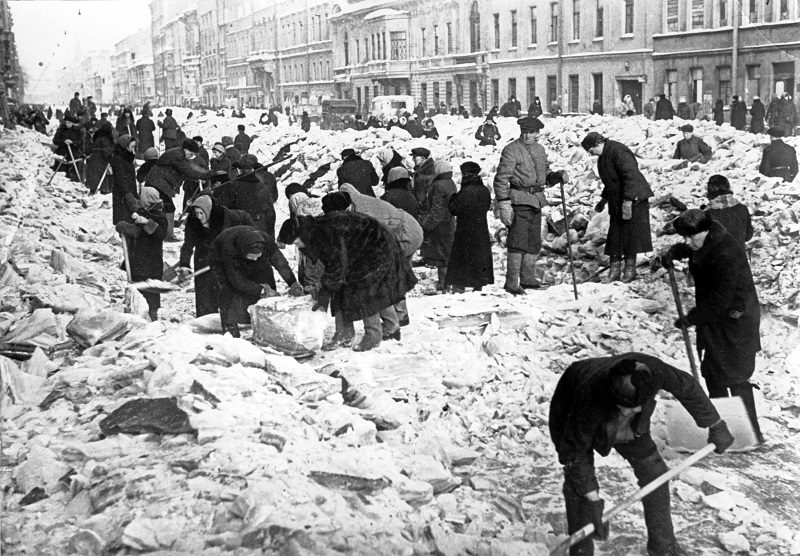
Residents clearing snow and ice from nevsky prospect in leningrad during world war ll, 1942. (Photo by: Sovfoto/UIG via Getty Images)[/caption]
When people think of the Eastern Front in World War II the Battle of Stalingrad is often the event that gets the most attention. However, the 900 Day Siege of Leningrad (modern day St. Petersburg) was also a brutal arena of war where the Nazis surrounded the city from 8 September 1941 to 27 January 1944. Instead of storming the city the Nazis laid siege, bombarding Leningrad and dropping propaganda leaflets over the city stating they were going to starve the people to surrender. During the siege an estimated 640,000 citizens died and people were driven to eating cats and sawdust. A story about the citizen population would be the wisest decision, showing how families would have dealt with these hardships and essentially be a citizen's eye view point of the frontline.
The legendary filmmaker Sergio Leone planned to make a film about the siege based on Harrison Salisbury's non-fiction book
The 900 Days: The Siege of Leningrad. Leone's plan was to cast Robert De Niro as an American photographer stuck behind enemy lines and in 1989 he raised a huge sum for the time, $100 Million, including from Soviet sources. But Leone died from a heart attack at the age of 60 and the film was scrapped.
The Dieppe Raid
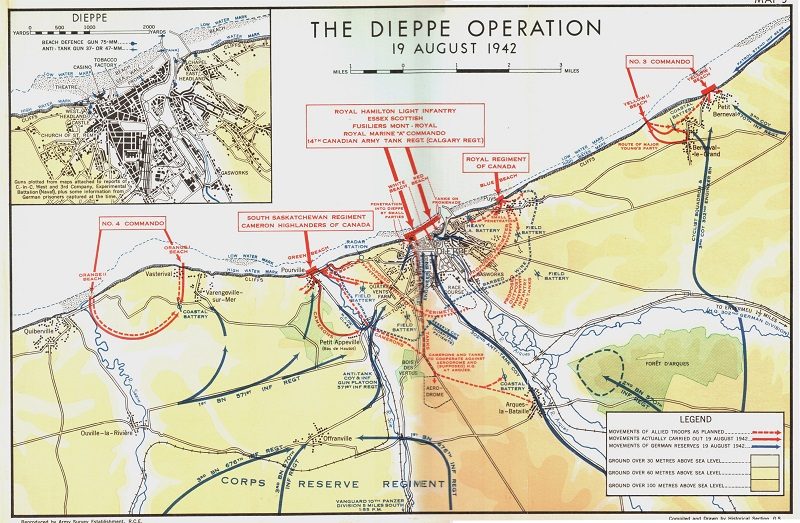
The last event from World War II to make it onto this list is the Dieppe Raid, an ambitious mission that ended up being a failure for the Allies. The aim of the Dieppe Raid was to test an ambitious invasion and the Allies choose to attack the town port of Dieppe in Normandy. The plan was to hold the port for a few hours before withdrawing and show that the Allies were still committed to the Western Front. However, the plan was overly complex and out of the 5,000 Canadian troops that were sent 3,367 were killed, wounded or captured and the event is particularly remembered in Canada. The silver lining was the Allies learned from the raid and choice to attack beaches instead of ports for Operation Torch and D-Day. Military historian David O'Keefe came up with the "Enigma Pinch" theory where the raid was a distraction so that British Commandos could steal an enigma machine from the Germans.
The model for a film about The Dieppe Raid would be
A Bridge Too Far, a 1977 film about Operation Marketgarden, another overly ambitious mission that was doomed to fail. A film about The Dieppe Raid could be a smaller scale war than some of the other that are on this list.
Srebrenica Massacre
[caption id="attachment_99832" align="aligncenter" width="800"]
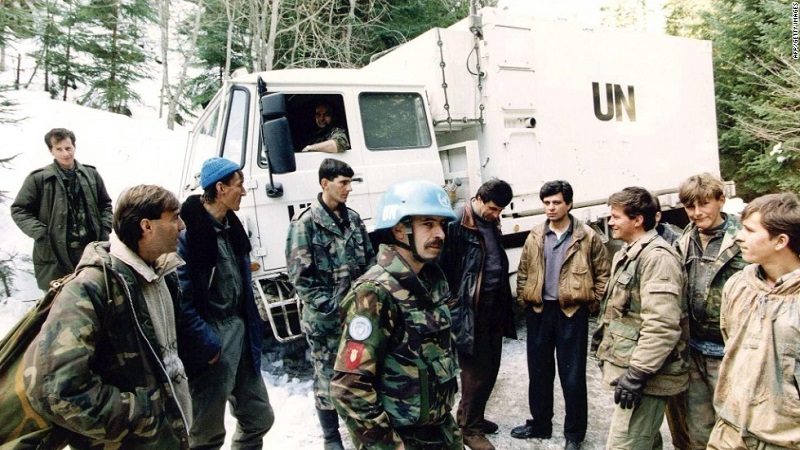
(FILES) -- A file photo taken on March 1, 1994 shows Dutch soldiers of a Dutchbat convoy chatting with Bosnian Muslim fighters in Vares, Bosnia. A court in the Netherlands ruled on July 16, 2014 that the Dutch state was responsible for the deaths of over 300 victims of the Srebrenica massacre, the worst atrocity on European soil since World War II. "The state is liable for the loss suffered by relatives of the men who were deported by the Bosnian Serbs from the Dutchbat (Dutch battalion) compound in Potocari in the afternoon of 13 July, 1995," the court said. Relatives had launched a lawsuit accusing Dutch UN peacekeepers of failing to protect the 8,000 Muslim men and boys killed.
AFP PHOTO / ANP / ED OUDENAARDEN -- The Netherlands out --ED OUDENAARDEN/AFP/Getty Images[/caption]
The most recent event to make it on this list is also one of the most tragic: The Srebrenica Massacre. The massacre took place in 1995 during the Balkan Wars where Croatia and Bosnia were attempting to break away from Yugoslavia, putting themselves into conflict with the Serbs. The Serbian leadership believed in a racist ideology of superiority, which Muslim Bosniaks were on the receiving end of.
In 1993 the UN declared the town of Srebrenica a safe zone for Bosnian refugees and Dutch troops for the UN were sent to protect the area. However, the Dutch troops were unable to stop the massacre which saw Republika Srpska and paramilitary Scorpions forces come into the town, rounded up military age men (as well as some teenagers and older men) who executed and women and girls were raped and sexually abused. In 2005 UN Security General Kofi Annan called the mass murder the worst crime on European soil since the Second World War.
A film about Srebrenica Massacre could go a number of directions - it could focus on the massacre itself and how the soldiers did nothing to stop or look at the aftermath in Bosnia or Holland. There were a number of investigations by both the Dutch government and the UN and the story could look at the impact of the event on the Bosniaks or the guilt Dutch soldiers would have suffered.
 The Peloponnesian War was a conflict between the Delian League led by Athens and Peloponnesian League that was lead by Sparta and supported by Persia (certainly puts 300 in a different light). It was a war that fought across Greece, Asia Minor and Sicily. The aftermath saw Greece fall to Spartan hegemony and ended Athenian democracy with the city being ruled by the Thirty Tyrants.
The Peloponnesian Wars saw a change in Greek warfare, turning from battles between heavily armored men in tight formations to bloodier affairs, where atrocities became more common and taboos were broken, like destroying religious sites.
Near the end of the war the famous philosopher Socrates was executed for his stance against democracy and his student Plato wrote The Republic. The Peloponnesian War has been seen as a failure for the Athenian model of Democracy and the trial of Socrates could be made as a condemnation of power the of the mob.
This was also the period the Athenian general and politician Pericles was alive and made his famous funeral oration which is one of the defenses of democracy.
The Life and Career of Hannibal Barca
The Peloponnesian War was a conflict between the Delian League led by Athens and Peloponnesian League that was lead by Sparta and supported by Persia (certainly puts 300 in a different light). It was a war that fought across Greece, Asia Minor and Sicily. The aftermath saw Greece fall to Spartan hegemony and ended Athenian democracy with the city being ruled by the Thirty Tyrants.
The Peloponnesian Wars saw a change in Greek warfare, turning from battles between heavily armored men in tight formations to bloodier affairs, where atrocities became more common and taboos were broken, like destroying religious sites.
Near the end of the war the famous philosopher Socrates was executed for his stance against democracy and his student Plato wrote The Republic. The Peloponnesian War has been seen as a failure for the Athenian model of Democracy and the trial of Socrates could be made as a condemnation of power the of the mob.
This was also the period the Athenian general and politician Pericles was alive and made his famous funeral oration which is one of the defenses of democracy.
The Life and Career of Hannibal Barca
 Hannibal is known as for being one of the best generals ever to have lived, the scourge of the Roman Empire and so influential that military academy still teaches his greatest successes. Hannibal fought for Carthage, an empire based in the Mediterranean that stretched across North Africa, Spain and islands like Corsica, Sardinia and Sicily and he was the great rival of Rome.
Hannibal started his military career in Spain and fought during the Second Punic War that lasted 17 years. Some of his greatest actions included crossing The Alps, a high-risk strategy - one-third of his forces died during the crossing but was able to bypass the Roman navy and surprised the Roman Republic by attacking their heartland. In Italy, Hannibal won three major battles, Trebia River, Lake Trasimene and Cannae. Canne was a complete humiliation for the Romans but as Hannibal's cavalry commander, Maharbal, said: "Hannibal knew indeed how to gain victories, but not how to use them." The Republic never surrendered and Hannibal never charged on Rome which would have forced their hand.
The Second Punic Wars also saw the rise of Scipio Africanus, an expert politician and military commander. He fought in Spain and was so popular with his troops that they wanted to crown him king, but Scipio refused. Scipio was able to force the Senate to allow him to invade Carthage and defeated Hannibal at the Battle of Zama.
All this material about Hannibal and the Second Punic War might be better served in a big budget mini-series, having production values like Rome or Game of Thrones. A film could still work, either as a three hour long epic or focus on a specific event like Hannibal's invasion of Italy, showing how the Roman Republic was brought to its knees.
The Battle of the Teutoburg Forest
Hannibal is known as for being one of the best generals ever to have lived, the scourge of the Roman Empire and so influential that military academy still teaches his greatest successes. Hannibal fought for Carthage, an empire based in the Mediterranean that stretched across North Africa, Spain and islands like Corsica, Sardinia and Sicily and he was the great rival of Rome.
Hannibal started his military career in Spain and fought during the Second Punic War that lasted 17 years. Some of his greatest actions included crossing The Alps, a high-risk strategy - one-third of his forces died during the crossing but was able to bypass the Roman navy and surprised the Roman Republic by attacking their heartland. In Italy, Hannibal won three major battles, Trebia River, Lake Trasimene and Cannae. Canne was a complete humiliation for the Romans but as Hannibal's cavalry commander, Maharbal, said: "Hannibal knew indeed how to gain victories, but not how to use them." The Republic never surrendered and Hannibal never charged on Rome which would have forced their hand.
The Second Punic Wars also saw the rise of Scipio Africanus, an expert politician and military commander. He fought in Spain and was so popular with his troops that they wanted to crown him king, but Scipio refused. Scipio was able to force the Senate to allow him to invade Carthage and defeated Hannibal at the Battle of Zama.
All this material about Hannibal and the Second Punic War might be better served in a big budget mini-series, having production values like Rome or Game of Thrones. A film could still work, either as a three hour long epic or focus on a specific event like Hannibal's invasion of Italy, showing how the Roman Republic was brought to its knees.
The Battle of the Teutoburg Forest
 In the year 9 AD the Roman Empire was at the height of its power, a dominant superpower under the rule of its first Emperor Augustus. One of the Empire's greatest defeats was losing against the Germanic Tribes in the forests of the North Rhine-Westphalia region of Germany and being forced to withdraw from Magna Germania.
At the time the Roman Empire was trying to expand beyond the Rhine and tame the Germanic tribes. Publius Quinctilius Varus, a general and politician with a reputation for being harsh, was sent the govern the province. However, Varus was tricked by Arminius, a Germanic prince who was raised as a Roman. Varus sent three legions to crush a potential uprising, leading him into the Teutoburg Forest but Arminius forced the Romans down narrow forest paths and used hit and run tactics to deplete the Roman forces, demoralizing the legions leading to a complete defeat. It was estimated that the Romans lost between 15,000-20,000 Legionaries and was forced to temporarily withdrawal from Magna Germania.
During the battle Varus and many other officers took their own lives. The Roman historian Suetonius reported that the Emperor was in a traumatized state, repeatedly shouting "Quintillius Varus, give me back my legions!" Arminius was considered to be a power-hungry politician, learning the Romans and planned to be the ruler of the Germanic Tribes - he was assassinated 10 years later by rival Germanic chiefs.
Boudica's Uprising
In the year 9 AD the Roman Empire was at the height of its power, a dominant superpower under the rule of its first Emperor Augustus. One of the Empire's greatest defeats was losing against the Germanic Tribes in the forests of the North Rhine-Westphalia region of Germany and being forced to withdraw from Magna Germania.
At the time the Roman Empire was trying to expand beyond the Rhine and tame the Germanic tribes. Publius Quinctilius Varus, a general and politician with a reputation for being harsh, was sent the govern the province. However, Varus was tricked by Arminius, a Germanic prince who was raised as a Roman. Varus sent three legions to crush a potential uprising, leading him into the Teutoburg Forest but Arminius forced the Romans down narrow forest paths and used hit and run tactics to deplete the Roman forces, demoralizing the legions leading to a complete defeat. It was estimated that the Romans lost between 15,000-20,000 Legionaries and was forced to temporarily withdrawal from Magna Germania.
During the battle Varus and many other officers took their own lives. The Roman historian Suetonius reported that the Emperor was in a traumatized state, repeatedly shouting "Quintillius Varus, give me back my legions!" Arminius was considered to be a power-hungry politician, learning the Romans and planned to be the ruler of the Germanic Tribes - he was assassinated 10 years later by rival Germanic chiefs.
Boudica's Uprising
 Boudica is a legendary figure in the United Kingdom, especially in England, the woman who defied an Empire and nearly forced the Romans out of Britain during her rebellion in of 60-61AD. The story of Boudica has already been explored by Entertainment Fuse, we suggested 10 actresses who play the famous red-head. Boudica's Rebellion has the perfect story template for a historical epic, similar to Spartacus, Gladiator and Braveheart. It would be brutal and bloody and could give the genre a feminist twist.
Boudica was married to Prasutagus, king of the Iceni tribe in modern-day Norfolk, England and an ally to the Roman Empire. When he died he left half his kingdom to the Roman Emperor and the other half to his daughters. However, the Romans refused to enact the deal, called in their loans and the kingdom was pillaged. Boudica was publicly flogged and her daughters were raped, an action that angered the Britons; they united behind Boudica. Boudica led the Britons to sack the Roman towns of Camulodunum, Londinium and Verulamium, burning them to the ground before being defeated at the Battle of Watling Street and taking her own life afterward.
Filmmakers wouldn't need to change the basic details to tell a good story and they will have some artistic license regarding Boudica's character because the only sources about her are Roman. There would have a ready-made villain in the form of Gaius Suetonius Paulinus, the Governor of Britain and was so brutal that the notorious Nero called him back to Rome after the campaign. Filmmakers could emphasis on themes of suppression and colonization, fighting off a foreign force, or look at the psychological impacted of the attack on Boudica, being a woman driven by a bloodthirsty vengeance.
Siege of Masada
Boudica is a legendary figure in the United Kingdom, especially in England, the woman who defied an Empire and nearly forced the Romans out of Britain during her rebellion in of 60-61AD. The story of Boudica has already been explored by Entertainment Fuse, we suggested 10 actresses who play the famous red-head. Boudica's Rebellion has the perfect story template for a historical epic, similar to Spartacus, Gladiator and Braveheart. It would be brutal and bloody and could give the genre a feminist twist.
Boudica was married to Prasutagus, king of the Iceni tribe in modern-day Norfolk, England and an ally to the Roman Empire. When he died he left half his kingdom to the Roman Emperor and the other half to his daughters. However, the Romans refused to enact the deal, called in their loans and the kingdom was pillaged. Boudica was publicly flogged and her daughters were raped, an action that angered the Britons; they united behind Boudica. Boudica led the Britons to sack the Roman towns of Camulodunum, Londinium and Verulamium, burning them to the ground before being defeated at the Battle of Watling Street and taking her own life afterward.
Filmmakers wouldn't need to change the basic details to tell a good story and they will have some artistic license regarding Boudica's character because the only sources about her are Roman. There would have a ready-made villain in the form of Gaius Suetonius Paulinus, the Governor of Britain and was so brutal that the notorious Nero called him back to Rome after the campaign. Filmmakers could emphasis on themes of suppression and colonization, fighting off a foreign force, or look at the psychological impacted of the attack on Boudica, being a woman driven by a bloodthirsty vengeance.
Siege of Masada
 The First Jewish-Roman War, also known as the Great Revolt, took place from 66 to 73AD in Judaea, modern day Israel and Palestine. One of the most famous events of this war came at the end of the conflict when the Romans laid siege of the Masada fort that was held by 960 Sicarii rebels, a group of zealots. Instead of surrendering the rebels committed mass suicide where only two women and five children survived.
This is a controversial event in Jewish and Israeli history and opinion is divided on how to treat the Sicarii rebels. Some argue that they were martyrs who fought bravely against the Romans and their deaths helped forge Israeli national identity. The other opinion is the Sicariis were just religious extremists who defied Jewish doctrine and serves as an example against people who twist religion for their own ends.
A film about Masada would certainly be interesting because it could explore what made the Sicarii tick and be a film about a cult in a historical setting. The desert setting and blood-letting could lead to a lot of Old Testament style imagery.
Battle of Tours
The First Jewish-Roman War, also known as the Great Revolt, took place from 66 to 73AD in Judaea, modern day Israel and Palestine. One of the most famous events of this war came at the end of the conflict when the Romans laid siege of the Masada fort that was held by 960 Sicarii rebels, a group of zealots. Instead of surrendering the rebels committed mass suicide where only two women and five children survived.
This is a controversial event in Jewish and Israeli history and opinion is divided on how to treat the Sicarii rebels. Some argue that they were martyrs who fought bravely against the Romans and their deaths helped forge Israeli national identity. The other opinion is the Sicariis were just religious extremists who defied Jewish doctrine and serves as an example against people who twist religion for their own ends.
A film about Masada would certainly be interesting because it could explore what made the Sicarii tick and be a film about a cult in a historical setting. The desert setting and blood-letting could lead to a lot of Old Testament style imagery.
Battle of Tours
 The Battle of Tours took place in 732 AD and it has been as a defining moment in European and Christian history because it prevented the Moors from advancing into Europe. The Moors were Arabs who conquered the most of the Iberian Peninsula (modern day Spain and Portugal) and attempted to invade the territory that would become France and the Moorish invaders marched to the rich city of Tours. However, the invasion led to warring kings and noblemen to unite to fight the foreign invaders, led by Charles Martel, Charles the Hammer. Despite being outnumbered and the Moors using cavalry the Christian forces were able to stand their ground and repel the invaders and even killed the Moors' commander, Abdul Rahman Al Ghafiqi.
There is a risk that a film about Battle of Tours could be hijacked by racists and Islamophobes, celebrating it as a story of Christianity's 'superiority' over Islam. To avoid this the film should either focus on the battle itself, show that 8th century was a brutal and unpleasant time regardless of ethnicity or religion or focus on Charles Martel who forms alliances and uses the victory to ignite his own ambitions for power (his grandson was Charlemagne).
The Gunpowder Plot
The Battle of Tours took place in 732 AD and it has been as a defining moment in European and Christian history because it prevented the Moors from advancing into Europe. The Moors were Arabs who conquered the most of the Iberian Peninsula (modern day Spain and Portugal) and attempted to invade the territory that would become France and the Moorish invaders marched to the rich city of Tours. However, the invasion led to warring kings and noblemen to unite to fight the foreign invaders, led by Charles Martel, Charles the Hammer. Despite being outnumbered and the Moors using cavalry the Christian forces were able to stand their ground and repel the invaders and even killed the Moors' commander, Abdul Rahman Al Ghafiqi.
There is a risk that a film about Battle of Tours could be hijacked by racists and Islamophobes, celebrating it as a story of Christianity's 'superiority' over Islam. To avoid this the film should either focus on the battle itself, show that 8th century was a brutal and unpleasant time regardless of ethnicity or religion or focus on Charles Martel who forms alliances and uses the victory to ignite his own ambitions for power (his grandson was Charlemagne).
The Gunpowder Plot
 "Remember, remember the fifth of November, Gunpowder treason and plot. We see no reason why gunpowder treason should ever be forgot!" The Gunpowder Plot that is taught to schoolchildren across England and commemorated with fireworks, bonfires, effigies and the annual searching the Palace of Westminster's cellars. However, most people outside the UK will properly know the event more because of V for Vendetta. Despite The Gunpowder Plot's cultural importance, there has never been a film about the Gunpowder Plot although there have been two miniseries.
The Gunpowder Plot took place within two years of the reign of James I (also James VI of Scotland), the Protestant king of Scotland who became the ruler of a religious divided England and was considered to be more tolerant of the Catholic faith than Elizabeth I. The conspirators, led by Robert Catesby planned to blow up the opening of Parliament, killing the king, his heir and many important MP and Lords and kidnap Princess Elizabeth so they could take over the regency.
A film about the Gunpowder Plot has a ready-made three act structure: James I becomes the king of England promising more religious tolerance but fails to enact on his promise, the conspirators plan to blow up Parliament and when they are found out they are tortured, tried and publicly executed in a brutal manner and the government unleashes a brutal backlash against Catholics in England.
There are two ways to make a film about The Gunpowder Plot: the first is it being a condemnation of an extremist group whose selfish actions made the conditions for Catholics in England even worse, ignoring Papal orders against rebellion. Many historians believe that even if the Plot was successful the results for Catholics would have been the same. The other way to go is to portray the conspirators as people forced to undertake this extreme action and martyr themselves for a greater cause. If filmmakers use the second option, they could easily use a lot of Catholic imagery and metaphor and the execution of Fr. Henry Garnet, the Jesuit Superior in England and loosely connected to the conspirator could have a certain level of martyrdom. During his execution the crowd pulled on his legs to kill him more quickly, sharing him the torture being quartered. When Garnet was beheaded there was no applause.
A more controversial story idea would be to look at the conspiracy theory that the Gunpowder Plot was an inside job lead by the Earl of Salisbury, framing Catholics so he could launch a new wave of terror.
The Careers of Edmund Burke and Thomas Paine
"Remember, remember the fifth of November, Gunpowder treason and plot. We see no reason why gunpowder treason should ever be forgot!" The Gunpowder Plot that is taught to schoolchildren across England and commemorated with fireworks, bonfires, effigies and the annual searching the Palace of Westminster's cellars. However, most people outside the UK will properly know the event more because of V for Vendetta. Despite The Gunpowder Plot's cultural importance, there has never been a film about the Gunpowder Plot although there have been two miniseries.
The Gunpowder Plot took place within two years of the reign of James I (also James VI of Scotland), the Protestant king of Scotland who became the ruler of a religious divided England and was considered to be more tolerant of the Catholic faith than Elizabeth I. The conspirators, led by Robert Catesby planned to blow up the opening of Parliament, killing the king, his heir and many important MP and Lords and kidnap Princess Elizabeth so they could take over the regency.
A film about the Gunpowder Plot has a ready-made three act structure: James I becomes the king of England promising more religious tolerance but fails to enact on his promise, the conspirators plan to blow up Parliament and when they are found out they are tortured, tried and publicly executed in a brutal manner and the government unleashes a brutal backlash against Catholics in England.
There are two ways to make a film about The Gunpowder Plot: the first is it being a condemnation of an extremist group whose selfish actions made the conditions for Catholics in England even worse, ignoring Papal orders against rebellion. Many historians believe that even if the Plot was successful the results for Catholics would have been the same. The other way to go is to portray the conspirators as people forced to undertake this extreme action and martyr themselves for a greater cause. If filmmakers use the second option, they could easily use a lot of Catholic imagery and metaphor and the execution of Fr. Henry Garnet, the Jesuit Superior in England and loosely connected to the conspirator could have a certain level of martyrdom. During his execution the crowd pulled on his legs to kill him more quickly, sharing him the torture being quartered. When Garnet was beheaded there was no applause.
A more controversial story idea would be to look at the conspiracy theory that the Gunpowder Plot was an inside job lead by the Earl of Salisbury, framing Catholics so he could launch a new wave of terror.
The Careers of Edmund Burke and Thomas Paine
 Edmund Burke and Thomas Paine were two different yet equally important political figures from in the late 18th Century whose ideas impacted the modern world. Edmund Burke was the MP for Bristol, part of the Whig Party in the House of Commons and considered the father of modern conservatism. Thomas Paine was a political radical and became an important figure in the American and French Revolutions.
During the American Revolution Burke and Paine were unlikely allies: both supported the American Revolution, although for different reasons. Burke saw fighting the American Revolutionaries as pointless because the British and Americans had the same political and ideological grounding and that the American Revolutionary was an evolution of the British system. Paine wrote the pamphlet "Common Sense" in 1776 and it was seen as one of the first text arguments for armed resistance. Written in deliberately easy to read style it sold 100,000 copies at time and it was considered one of the most important pamphlets during the revolution.
It was during the French Revolution where the two men were opposed to each other. Paine when to France to support the revolution while Burke wrote his influential text "Reflections on the Revolution in France", the book that was the bedrock for conservative ideology in 1790 as well as an attack on actions of the French Revolution because he thought political change would eventually happen.
Paine's response was publishing his most famous pamphlet "Rights of Man", arguing that the revolution was justified because the people were overthrowing a tyrant abusing his position.
A rivalry flared up in 1792 when Paine attacked Burke and led to his trial and conviction for seditious libel, done in absentia. Paine was also elected to the French National Convention but was arrested and imprisoned in December 1793, luckily escaping with his life.
Despite the men possibly never meeting, a film or miniseries about both men who would be an interesting exploration of two men who were ideologically opposed at a time of political upheaval and examination of what makes them tick. There is a risk that a production about political philosophy would be a turn off for audiences, but films like Lincoln and TV shows like House of Cards have proven that people will watch media about politics.
Battle of Trafalgar
Edmund Burke and Thomas Paine were two different yet equally important political figures from in the late 18th Century whose ideas impacted the modern world. Edmund Burke was the MP for Bristol, part of the Whig Party in the House of Commons and considered the father of modern conservatism. Thomas Paine was a political radical and became an important figure in the American and French Revolutions.
During the American Revolution Burke and Paine were unlikely allies: both supported the American Revolution, although for different reasons. Burke saw fighting the American Revolutionaries as pointless because the British and Americans had the same political and ideological grounding and that the American Revolutionary was an evolution of the British system. Paine wrote the pamphlet "Common Sense" in 1776 and it was seen as one of the first text arguments for armed resistance. Written in deliberately easy to read style it sold 100,000 copies at time and it was considered one of the most important pamphlets during the revolution.
It was during the French Revolution where the two men were opposed to each other. Paine when to France to support the revolution while Burke wrote his influential text "Reflections on the Revolution in France", the book that was the bedrock for conservative ideology in 1790 as well as an attack on actions of the French Revolution because he thought political change would eventually happen.
Paine's response was publishing his most famous pamphlet "Rights of Man", arguing that the revolution was justified because the people were overthrowing a tyrant abusing his position.
A rivalry flared up in 1792 when Paine attacked Burke and led to his trial and conviction for seditious libel, done in absentia. Paine was also elected to the French National Convention but was arrested and imprisoned in December 1793, luckily escaping with his life.
Despite the men possibly never meeting, a film or miniseries about both men who would be an interesting exploration of two men who were ideologically opposed at a time of political upheaval and examination of what makes them tick. There is a risk that a production about political philosophy would be a turn off for audiences, but films like Lincoln and TV shows like House of Cards have proven that people will watch media about politics.
Battle of Trafalgar
 The Battle of Trafalgar is a battle that stands alongside Agincourt and Waterloo that fill Englishmen with patriotic pride and for a nation known for its naval tradition Trafalgar is considered one of its most important victories. Before the battle war between Britain and France flared up and Napoleon wanted to invade Britain. But for any nation to invade Britain they need control of the seas. Just off the coast of Cape Trafalgar in the South-west of Spain Admiral Horatio Nelson launched an attack against a joint French-Spanish fleet and despite being outnumbered the British did not lose a single ship while the French and Spanish lost 21 ships. The battle tactics were revolutionary and Trafalgar is still studied by aspiring naval officers. However, despite it being Nelson's greatest triumph he died during the battle.
Films about naval warfare are expensive because of the sets required and shooting on water being incredibly difficult but a film about the Battle of Trafalgar is still perfectly possible. 2003's Master and Commander: The Far Side of the World was set in the same period was a critical hit and nominated for 10 Oscars, it just had the misfortune of competing against Lord of the Rings: Return of the King and its award winning clean sweep. 2003 also saw the release of Pirates of the Caribbean: Curse of the Black Pearl which was a huge hit and started a popular series. The Pirates of the Caribbean could serve as an example of how a film about the Battle of Trafalgar could face the technical challenge and be the basis for how to shoot action scenes and art direction. A Battle of Trafalgar could be a great film to show the hardship of naval life at the time and be violent because of cannonballs shaming into ships and men having to fight hand-to-hand battles.
The other way to go would be to make a biopic about Nelson, a man from a modest background who rose up the ranks and was popular with the people but hated by the Admiralty. He led the Royal Navy to victories in Egypt and Denmark, but was seen as a maverick and attracted scandal when he had an affair with Emma Hamilton. When he died Nelson had a state funeral which 32 admirals and over hundred captains attended and an escort of 10,000 soldiers but his wife and daughter were not allowed to attend.
The Presidency of Andrew Jackson
The Battle of Trafalgar is a battle that stands alongside Agincourt and Waterloo that fill Englishmen with patriotic pride and for a nation known for its naval tradition Trafalgar is considered one of its most important victories. Before the battle war between Britain and France flared up and Napoleon wanted to invade Britain. But for any nation to invade Britain they need control of the seas. Just off the coast of Cape Trafalgar in the South-west of Spain Admiral Horatio Nelson launched an attack against a joint French-Spanish fleet and despite being outnumbered the British did not lose a single ship while the French and Spanish lost 21 ships. The battle tactics were revolutionary and Trafalgar is still studied by aspiring naval officers. However, despite it being Nelson's greatest triumph he died during the battle.
Films about naval warfare are expensive because of the sets required and shooting on water being incredibly difficult but a film about the Battle of Trafalgar is still perfectly possible. 2003's Master and Commander: The Far Side of the World was set in the same period was a critical hit and nominated for 10 Oscars, it just had the misfortune of competing against Lord of the Rings: Return of the King and its award winning clean sweep. 2003 also saw the release of Pirates of the Caribbean: Curse of the Black Pearl which was a huge hit and started a popular series. The Pirates of the Caribbean could serve as an example of how a film about the Battle of Trafalgar could face the technical challenge and be the basis for how to shoot action scenes and art direction. A Battle of Trafalgar could be a great film to show the hardship of naval life at the time and be violent because of cannonballs shaming into ships and men having to fight hand-to-hand battles.
The other way to go would be to make a biopic about Nelson, a man from a modest background who rose up the ranks and was popular with the people but hated by the Admiralty. He led the Royal Navy to victories in Egypt and Denmark, but was seen as a maverick and attracted scandal when he had an affair with Emma Hamilton. When he died Nelson had a state funeral which 32 admirals and over hundred captains attended and an escort of 10,000 soldiers but his wife and daughter were not allowed to attend.
The Presidency of Andrew Jackson
 Andrew Jackson is often considered to be the insane man to hold the office of President of the United States and the current occupant of the White House has been compared to the man on the 20 dollar bill - so it would be timely for a film about Jackson's time in office to be made. Before running for office Andrew Jackson was a general before becoming President, commanding the US Army during the Battle of New Orleans and was the military commander in Florida, fighting against Native American tribes without the authorization of the Federal Government. Jackson was also known for having a violent temper and fondness for dueling
Jackson ran on a populist platform and during the 1828 Presidential Election he campaigned using his military experience and criticized his opponent John Quincy Adams for his intellect. During Jackson's inauguration he hosted a drunken party at the White House and was the first sitting president to survive an assassination attempt and when the would-be assassin's pistols failed to fire Jackson beat him with his cane.
Jackson was also known for expanding Presidential power. During his time in office he ran afoul with South Carolina during the Nullification Crisis which nearly led to the army and navy to the collect taxes and forced to renew the Second Bank of the United States which led to the Panic of 1837. He also used the Presidential veto as a political weapon and notorious for cronyism. His most notorious act was supporting the Indian Removal Act which led to the Native Americans being forced from the lands in the South and moved Westwards. The Native Americans' even successfully sued the government and Jackson supposed reaction was 'let's see how the court would enforce it'.
A biopic about Jackson's political life could happen in two ways: the first could be a serious political drama where a powerhungry mad man was able to appeal to the masses and attempts to fight against the system of checks-and-balance. The other way would be a dark comedy about a clearly insane man holding the highest office in the land. Either way the film could act as a critique of Donald Trump.
The Founding of HMP Pentonville
Andrew Jackson is often considered to be the insane man to hold the office of President of the United States and the current occupant of the White House has been compared to the man on the 20 dollar bill - so it would be timely for a film about Jackson's time in office to be made. Before running for office Andrew Jackson was a general before becoming President, commanding the US Army during the Battle of New Orleans and was the military commander in Florida, fighting against Native American tribes without the authorization of the Federal Government. Jackson was also known for having a violent temper and fondness for dueling
Jackson ran on a populist platform and during the 1828 Presidential Election he campaigned using his military experience and criticized his opponent John Quincy Adams for his intellect. During Jackson's inauguration he hosted a drunken party at the White House and was the first sitting president to survive an assassination attempt and when the would-be assassin's pistols failed to fire Jackson beat him with his cane.
Jackson was also known for expanding Presidential power. During his time in office he ran afoul with South Carolina during the Nullification Crisis which nearly led to the army and navy to the collect taxes and forced to renew the Second Bank of the United States which led to the Panic of 1837. He also used the Presidential veto as a political weapon and notorious for cronyism. His most notorious act was supporting the Indian Removal Act which led to the Native Americans being forced from the lands in the South and moved Westwards. The Native Americans' even successfully sued the government and Jackson supposed reaction was 'let's see how the court would enforce it'.
A biopic about Jackson's political life could happen in two ways: the first could be a serious political drama where a powerhungry mad man was able to appeal to the masses and attempts to fight against the system of checks-and-balance. The other way would be a dark comedy about a clearly insane man holding the highest office in the land. Either way the film could act as a critique of Donald Trump.
The Founding of HMP Pentonville
 HMP Pentonville was a Victorian prison that opened in 1842 and was seen as a response to the criminal justice system known as 'The Bloody Code' by its critics. It was during this period that saw a change in how crimes were punished in the UK, moving away from physical punishment to punishing the mind and within the walls of Pentonville extreme measures were taken. Prisoners were forced to wear masks and were not permitted to speak to each other. At night prisoners screamed in pain because of the psychological torment and within Pentonville there were 220 cases of insanity, 210 cases of delusion and 40 suicides. This experiment in criminal justice would be a perfect setting for a historical horror film where prisoners undergo this cruel and unusual punishment, an eerie setting of faceless people and silence and prisoners' sanity pushed to the brink.
Mary Seacole
HMP Pentonville was a Victorian prison that opened in 1842 and was seen as a response to the criminal justice system known as 'The Bloody Code' by its critics. It was during this period that saw a change in how crimes were punished in the UK, moving away from physical punishment to punishing the mind and within the walls of Pentonville extreme measures were taken. Prisoners were forced to wear masks and were not permitted to speak to each other. At night prisoners screamed in pain because of the psychological torment and within Pentonville there were 220 cases of insanity, 210 cases of delusion and 40 suicides. This experiment in criminal justice would be a perfect setting for a historical horror film where prisoners undergo this cruel and unusual punishment, an eerie setting of faceless people and silence and prisoners' sanity pushed to the brink.
Mary Seacole
 When people think of pioneer of modern nursing Florence Nightingale is the face of it and made a hero of the Crimean War. However, a contemporary that was just as important and but largely forgotten was Mary Seacole.
Mary Seacole was mixed-race Jamaican woman who trained as a nurse who treated gold prosperities who was traveling through Panama before moving to London to volunteer to serve in the war effort but was rejected by the Ministry of War. Despite this Seacole went to the Crimea to treat British troops privately in the British Hotel near Balaclava and became popular with the troops.
Seacole was a well-known figure in the Victorian England, she was one of the first mixed-race women to write an autobiography and because of her charitable work her financial situation fluctuated, yet her legacy was forgotten until recently. I only found out about her when studying A-Level Sociology and she was used as an example about how the achievements of people from ethnic minorities are marginalized. She was posthumously awarded the Jamaican Order of Merit in 1991 and was voted the greatest black Briton.
A film about Seacole would focus on her time in the Crimea, how she had used all her money and be extremely resourceful to set up the British Hotel and show a woman with huge passion and compassion in an era where she would have suffered incredible prejudice.
The Battle of Verdun
[caption id="attachment_99826" align="aligncenter" width="627"]
When people think of pioneer of modern nursing Florence Nightingale is the face of it and made a hero of the Crimean War. However, a contemporary that was just as important and but largely forgotten was Mary Seacole.
Mary Seacole was mixed-race Jamaican woman who trained as a nurse who treated gold prosperities who was traveling through Panama before moving to London to volunteer to serve in the war effort but was rejected by the Ministry of War. Despite this Seacole went to the Crimea to treat British troops privately in the British Hotel near Balaclava and became popular with the troops.
Seacole was a well-known figure in the Victorian England, she was one of the first mixed-race women to write an autobiography and because of her charitable work her financial situation fluctuated, yet her legacy was forgotten until recently. I only found out about her when studying A-Level Sociology and she was used as an example about how the achievements of people from ethnic minorities are marginalized. She was posthumously awarded the Jamaican Order of Merit in 1991 and was voted the greatest black Briton.
A film about Seacole would focus on her time in the Crimea, how she had used all her money and be extremely resourceful to set up the British Hotel and show a woman with huge passion and compassion in an era where she would have suffered incredible prejudice.
The Battle of Verdun
[caption id="attachment_99826" align="aligncenter" width="627"] World War One, Battle of Verdun. French trench on the front lines, 1916. (Photo by Roger Viollet/Getty Images)[/caption]
The Battle of Verdun one of the most costly battles in human history, let alone in World War One. Commencing from 21 February 1916 to 18 December 1916 the battle was fought between the French and the German armies. The battle tactics were a cynical disregard for human life and a symbol of the worst stereotypes of military tactics during the First World War. The aim of the battle from the German point-of-view was to make the battle so bloody that it would force the Allies, particularly the French to sue for peace because of the huge loss of life. The aim of the Germans was to attack Verdun and the action would force the French reserves into the battle.
The battle was the brainchild of Erich von Falkenhayn, the Chief of the German Staff, and can easily be the villain of the piece because his aim was simply to cause as much death as possible. A film about the Battle of Verdun could follow in the tradition of All Quiet on the Western Front and Paths of Glory, showing brave men, fighting in horrific conditions, but were nothing more than pawns of the higher ups who live in luxury.
The Great Emu War
World War One, Battle of Verdun. French trench on the front lines, 1916. (Photo by Roger Viollet/Getty Images)[/caption]
The Battle of Verdun one of the most costly battles in human history, let alone in World War One. Commencing from 21 February 1916 to 18 December 1916 the battle was fought between the French and the German armies. The battle tactics were a cynical disregard for human life and a symbol of the worst stereotypes of military tactics during the First World War. The aim of the battle from the German point-of-view was to make the battle so bloody that it would force the Allies, particularly the French to sue for peace because of the huge loss of life. The aim of the Germans was to attack Verdun and the action would force the French reserves into the battle.
The battle was the brainchild of Erich von Falkenhayn, the Chief of the German Staff, and can easily be the villain of the piece because his aim was simply to cause as much death as possible. A film about the Battle of Verdun could follow in the tradition of All Quiet on the Western Front and Paths of Glory, showing brave men, fighting in horrific conditions, but were nothing more than pawns of the higher ups who live in luxury.
The Great Emu War
 Pretty much all these entries on this list are major events and most would be serious dramas or war films, so let's look at an event that would be turned into an outright comedy: The Great Emu War of 1932.
After the First World War a large number of Australian and British veterans moved to Western Australia to become farmers. However, the new farm land was directly in the path of Emu migration routes and the new farmers lobbied the Australian government to help them cull the animals. The Australian government sent one officer and two soldiers with a machine - the government reasoning being the Emus would be good target practice. What happened was the birds outsmarted the military: the first attempt to shoot the Emus resulted in failure when the gun jammed and the birds ran off and scattered. The officer in command then decided to put the machine gun on the back of a truck but when it came to be used the soldier was unable to use it because he had to hang on for dear life. In the end, 986 emus were killed at a ratio of 10 bullets used to kill one bird and the Australian army withdrew in humiliation.
Group Captain Douglas Bader
Pretty much all these entries on this list are major events and most would be serious dramas or war films, so let's look at an event that would be turned into an outright comedy: The Great Emu War of 1932.
After the First World War a large number of Australian and British veterans moved to Western Australia to become farmers. However, the new farm land was directly in the path of Emu migration routes and the new farmers lobbied the Australian government to help them cull the animals. The Australian government sent one officer and two soldiers with a machine - the government reasoning being the Emus would be good target practice. What happened was the birds outsmarted the military: the first attempt to shoot the Emus resulted in failure when the gun jammed and the birds ran off and scattered. The officer in command then decided to put the machine gun on the back of a truck but when it came to be used the soldier was unable to use it because he had to hang on for dear life. In the end, 986 emus were killed at a ratio of 10 bullets used to kill one bird and the Australian army withdrew in humiliation.
Group Captain Douglas Bader
 Douglas Bader was a Royal Air Force pilot who served during the Battle of France and Battle of Britain. What makes his story even more remarkable was he lost both his legs in an accident in 1931 and was forced to retire from the military and only allowed back into the RAF as a pilot because of the outbreak of war.
Bader was recorded having 22 aerial victories, for shared victories, six probable victories, one probable shared victory and damaging 11 enemy aircraft. An impressive record for any pilot. Bader was also not afraid to ruffle feathers with the RAF, supporting the Big Wing theory which was a huge debate at the time.
Bader was captured by the Germans after being shot down over France and despite his disability attempted to escape, leading him to be transferred to 'escape-proof' Colditz Castle.
After the war Bader became a campaigner for disabled rights and earned himself a knighthood in 1976 because of his work.
The Battle of El-Alamein
Douglas Bader was a Royal Air Force pilot who served during the Battle of France and Battle of Britain. What makes his story even more remarkable was he lost both his legs in an accident in 1931 and was forced to retire from the military and only allowed back into the RAF as a pilot because of the outbreak of war.
Bader was recorded having 22 aerial victories, for shared victories, six probable victories, one probable shared victory and damaging 11 enemy aircraft. An impressive record for any pilot. Bader was also not afraid to ruffle feathers with the RAF, supporting the Big Wing theory which was a huge debate at the time.
Bader was captured by the Germans after being shot down over France and despite his disability attempted to escape, leading him to be transferred to 'escape-proof' Colditz Castle.
After the war Bader became a campaigner for disabled rights and earned himself a knighthood in 1976 because of his work.
The Battle of El-Alamein
 The Battle of El-Alamein is an important turning point in the North Africa Campaign where the Nazi advance was halted and pushed back once and for all, giving the Allies a morale boosting victory. A film about El-Alamein could see a return of films about major battles, like The Longest Day, Tora Tora Tora and A Bridge Too Far, looking at the commanders and men on the ground.
The Battle of El-Alamein was really two battles. The first was a defensive battle designed to stop the Germans and took place from 1 July to 27 July 1942. The second battle took place three months later and saw the Allies advance against the Germans, coinciding with Operation Torch, the Allied invasion of French North Africa.
The most obvious way to make a film about El-Alamein would be to focus on the two commanders, Field Marshall Erwin Rommel of the Panzerarmee Afrika, nicknamed the Desert Fox and Lieutenant-General Bernard "Monty" Montgomery, taking over command of the Allied Army for the Second Battle. A film would focus on the commanders' preparation for the battle and the tactical battle of wits between two of greatest commanders during the war while also facing pressure from their political superiors. Montgomery was tasked to lead an offensive battle because the Soviets demanded an attack to alleviate pressure on the Eastern Front.
The Arctic Convoys
The Battle of El-Alamein is an important turning point in the North Africa Campaign where the Nazi advance was halted and pushed back once and for all, giving the Allies a morale boosting victory. A film about El-Alamein could see a return of films about major battles, like The Longest Day, Tora Tora Tora and A Bridge Too Far, looking at the commanders and men on the ground.
The Battle of El-Alamein was really two battles. The first was a defensive battle designed to stop the Germans and took place from 1 July to 27 July 1942. The second battle took place three months later and saw the Allies advance against the Germans, coinciding with Operation Torch, the Allied invasion of French North Africa.
The most obvious way to make a film about El-Alamein would be to focus on the two commanders, Field Marshall Erwin Rommel of the Panzerarmee Afrika, nicknamed the Desert Fox and Lieutenant-General Bernard "Monty" Montgomery, taking over command of the Allied Army for the Second Battle. A film would focus on the commanders' preparation for the battle and the tactical battle of wits between two of greatest commanders during the war while also facing pressure from their political superiors. Montgomery was tasked to lead an offensive battle because the Soviets demanded an attack to alleviate pressure on the Eastern Front.
The Arctic Convoys
 Winston Churchill called the Arctic Convoys 'the worst journey in the world', a hard arena of war where the Allies sent materials and aid to support the Soviet War Effort. After the Nazis invaded the Soviet Union the American policy of Lend-Lease was extended to their new found ally. The best way to supply the Soviets was sending large shipments to northern ports of Arkhangelsk and Murmansk. But this was also the most dangerous route because Allied ships had to go pass Nazi-occupied Norway and face the harshest sailing conditions possible. Ships were bombarded by German sea and air forces.
During this period 3000 seamen lost their lives, the Allies lost 85 merchant ships and 16 warships while the Germans lost four warships and 30 submarines. The worst hit convoy was PQ 17 which sailed from Iceland to Arkhangelsk from 27 June 1942. Out of 35 ships, only 11 made it to the Soviet Union and it forced a temporary suspension of the convoys.
The sailors were honored in 2012 by the British Government with their own medal The Arctic Star. The first was awarded in March 2013. Any film about the Arctic Convoys would need to focus on the sailors who fought in some of the harshest conditions possible and a celebration of their bravery.
The Siege of Leningrad
[caption id="attachment_99830" align="aligncenter" width="800"]
Winston Churchill called the Arctic Convoys 'the worst journey in the world', a hard arena of war where the Allies sent materials and aid to support the Soviet War Effort. After the Nazis invaded the Soviet Union the American policy of Lend-Lease was extended to their new found ally. The best way to supply the Soviets was sending large shipments to northern ports of Arkhangelsk and Murmansk. But this was also the most dangerous route because Allied ships had to go pass Nazi-occupied Norway and face the harshest sailing conditions possible. Ships were bombarded by German sea and air forces.
During this period 3000 seamen lost their lives, the Allies lost 85 merchant ships and 16 warships while the Germans lost four warships and 30 submarines. The worst hit convoy was PQ 17 which sailed from Iceland to Arkhangelsk from 27 June 1942. Out of 35 ships, only 11 made it to the Soviet Union and it forced a temporary suspension of the convoys.
The sailors were honored in 2012 by the British Government with their own medal The Arctic Star. The first was awarded in March 2013. Any film about the Arctic Convoys would need to focus on the sailors who fought in some of the harshest conditions possible and a celebration of their bravery.
The Siege of Leningrad
[caption id="attachment_99830" align="aligncenter" width="800"] Residents clearing snow and ice from nevsky prospect in leningrad during world war ll, 1942. (Photo by: Sovfoto/UIG via Getty Images)[/caption]
When people think of the Eastern Front in World War II the Battle of Stalingrad is often the event that gets the most attention. However, the 900 Day Siege of Leningrad (modern day St. Petersburg) was also a brutal arena of war where the Nazis surrounded the city from 8 September 1941 to 27 January 1944. Instead of storming the city the Nazis laid siege, bombarding Leningrad and dropping propaganda leaflets over the city stating they were going to starve the people to surrender. During the siege an estimated 640,000 citizens died and people were driven to eating cats and sawdust. A story about the citizen population would be the wisest decision, showing how families would have dealt with these hardships and essentially be a citizen's eye view point of the frontline.
The legendary filmmaker Sergio Leone planned to make a film about the siege based on Harrison Salisbury's non-fiction book The 900 Days: The Siege of Leningrad. Leone's plan was to cast Robert De Niro as an American photographer stuck behind enemy lines and in 1989 he raised a huge sum for the time, $100 Million, including from Soviet sources. But Leone died from a heart attack at the age of 60 and the film was scrapped.
The Dieppe Raid
Residents clearing snow and ice from nevsky prospect in leningrad during world war ll, 1942. (Photo by: Sovfoto/UIG via Getty Images)[/caption]
When people think of the Eastern Front in World War II the Battle of Stalingrad is often the event that gets the most attention. However, the 900 Day Siege of Leningrad (modern day St. Petersburg) was also a brutal arena of war where the Nazis surrounded the city from 8 September 1941 to 27 January 1944. Instead of storming the city the Nazis laid siege, bombarding Leningrad and dropping propaganda leaflets over the city stating they were going to starve the people to surrender. During the siege an estimated 640,000 citizens died and people were driven to eating cats and sawdust. A story about the citizen population would be the wisest decision, showing how families would have dealt with these hardships and essentially be a citizen's eye view point of the frontline.
The legendary filmmaker Sergio Leone planned to make a film about the siege based on Harrison Salisbury's non-fiction book The 900 Days: The Siege of Leningrad. Leone's plan was to cast Robert De Niro as an American photographer stuck behind enemy lines and in 1989 he raised a huge sum for the time, $100 Million, including from Soviet sources. But Leone died from a heart attack at the age of 60 and the film was scrapped.
The Dieppe Raid
 The last event from World War II to make it onto this list is the Dieppe Raid, an ambitious mission that ended up being a failure for the Allies. The aim of the Dieppe Raid was to test an ambitious invasion and the Allies choose to attack the town port of Dieppe in Normandy. The plan was to hold the port for a few hours before withdrawing and show that the Allies were still committed to the Western Front. However, the plan was overly complex and out of the 5,000 Canadian troops that were sent 3,367 were killed, wounded or captured and the event is particularly remembered in Canada. The silver lining was the Allies learned from the raid and choice to attack beaches instead of ports for Operation Torch and D-Day. Military historian David O'Keefe came up with the "Enigma Pinch" theory where the raid was a distraction so that British Commandos could steal an enigma machine from the Germans.
The model for a film about The Dieppe Raid would be A Bridge Too Far, a 1977 film about Operation Marketgarden, another overly ambitious mission that was doomed to fail. A film about The Dieppe Raid could be a smaller scale war than some of the other that are on this list.
Srebrenica Massacre
[caption id="attachment_99832" align="aligncenter" width="800"]
The last event from World War II to make it onto this list is the Dieppe Raid, an ambitious mission that ended up being a failure for the Allies. The aim of the Dieppe Raid was to test an ambitious invasion and the Allies choose to attack the town port of Dieppe in Normandy. The plan was to hold the port for a few hours before withdrawing and show that the Allies were still committed to the Western Front. However, the plan was overly complex and out of the 5,000 Canadian troops that were sent 3,367 were killed, wounded or captured and the event is particularly remembered in Canada. The silver lining was the Allies learned from the raid and choice to attack beaches instead of ports for Operation Torch and D-Day. Military historian David O'Keefe came up with the "Enigma Pinch" theory where the raid was a distraction so that British Commandos could steal an enigma machine from the Germans.
The model for a film about The Dieppe Raid would be A Bridge Too Far, a 1977 film about Operation Marketgarden, another overly ambitious mission that was doomed to fail. A film about The Dieppe Raid could be a smaller scale war than some of the other that are on this list.
Srebrenica Massacre
[caption id="attachment_99832" align="aligncenter" width="800"] (FILES) -- A file photo taken on March 1, 1994 shows Dutch soldiers of a Dutchbat convoy chatting with Bosnian Muslim fighters in Vares, Bosnia. A court in the Netherlands ruled on July 16, 2014 that the Dutch state was responsible for the deaths of over 300 victims of the Srebrenica massacre, the worst atrocity on European soil since World War II. "The state is liable for the loss suffered by relatives of the men who were deported by the Bosnian Serbs from the Dutchbat (Dutch battalion) compound in Potocari in the afternoon of 13 July, 1995," the court said. Relatives had launched a lawsuit accusing Dutch UN peacekeepers of failing to protect the 8,000 Muslim men and boys killed.
(FILES) -- A file photo taken on March 1, 1994 shows Dutch soldiers of a Dutchbat convoy chatting with Bosnian Muslim fighters in Vares, Bosnia. A court in the Netherlands ruled on July 16, 2014 that the Dutch state was responsible for the deaths of over 300 victims of the Srebrenica massacre, the worst atrocity on European soil since World War II. "The state is liable for the loss suffered by relatives of the men who were deported by the Bosnian Serbs from the Dutchbat (Dutch battalion) compound in Potocari in the afternoon of 13 July, 1995," the court said. Relatives had launched a lawsuit accusing Dutch UN peacekeepers of failing to protect the 8,000 Muslim men and boys killed.